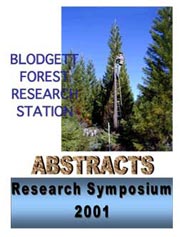The Stand Visualization System (SVS), a software program that depicts trees, is frequently used to create images for forest plans, public presentations, and research reports. For this case study, we are comparing people’s perceptions of SVS images to their perceptions of real plots in the forest, to see if the classification of forest structure is identical. In the fall of 2000, four groups of visitors to Blodgett Forest viewed a 20-minute Powerpoint presentation containing SVS images (fig. 1). For each image, visitors answered 5 questions about stand size class, age, and canopy density. Visitors then participated in a 1-hour walk to the 7 plots used to generate the SVS images and answered the same set of questions. Structure classes in the questionnaire were based on those of the California Wildlife Habitat Relationships system. Results are currently being analyzed to see if classification responses differ between real and virtual plots, between SVS images of 0.10 acre and 0.50 acre plots, and between individuals with different self-rated levels of know-ledge about forests. The research is intended to be useful to those who use SVS to communicate with the public about forest issues.
 Figure 1. SVS 0.50 acre image of Blodgett Forest compartment 230 plot 28. Figure 1. SVS 0.50 acre image of Blodgett Forest compartment 230 plot 28.
|

 Figure 1. SVS 0.50 acre image of Blodgett Forest compartment 230 plot 28.
Figure 1. SVS 0.50 acre image of Blodgett Forest compartment 230 plot 28.